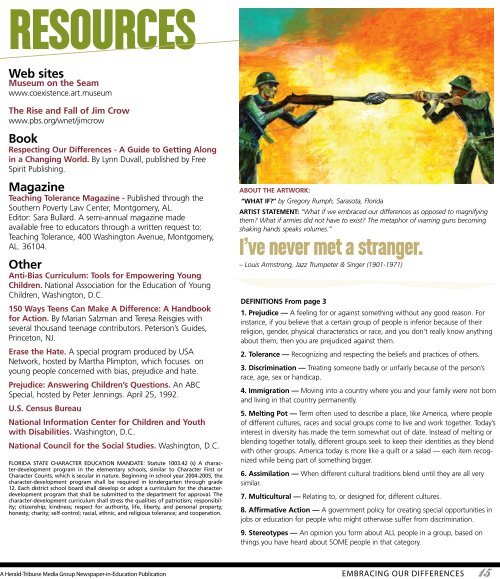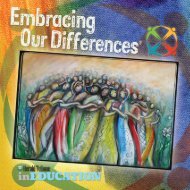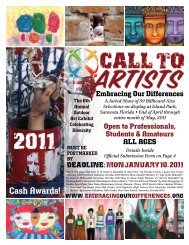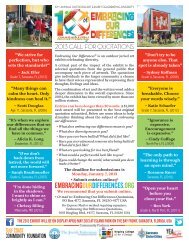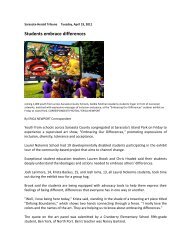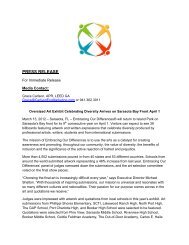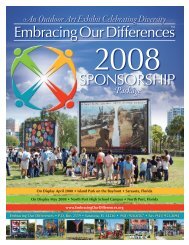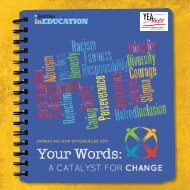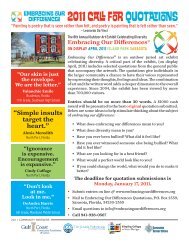Diversity - Embracing Our Differences
Diversity - Embracing Our Differences
Diversity - Embracing Our Differences
Create successful ePaper yourself
Turn your PDF publications into a flip-book with our unique Google optimized e-Paper software.
RESOURCES<br />
Web sites<br />
Museum on the Seam<br />
www.coexistence.art.museum<br />
The Rise and Fall of Jim Crow<br />
www.pbs.org/wnet/jimcrow<br />
Book<br />
Respecting <strong>Our</strong> <strong>Differences</strong> - A Guide to Getting Along<br />
in a Changing World. By Lynn Duvall, published by Free<br />
Spirit Publishing.<br />
Magazine<br />
Teaching Tolerance Magazine - Published through the<br />
Southern Poverty Law Center, Montgomery, AL.<br />
Editor: Sara Bullard. A semi-annual magazine made<br />
available free to educators through a written request to:<br />
Teaching Tolerance, 400 Washington Avenue, Montgomery,<br />
AL. 36104.<br />
Other<br />
Anti-Bias Curriculum: Tools for Empowering Young<br />
Children. National Association for the Education of Young<br />
Children, Washington, D.C.<br />
150 Ways Teens Can Make A Difference: A Handbook<br />
for Action. By Marian Salzman and Teresa Reisgies with<br />
several thousand teenage contributors. Peterson’s Guides,<br />
Princeton, NJ.<br />
Erase the Hate. A special program produced by USA<br />
Network, hosted by Martha Plimpton, which focuses on<br />
young people concerned with bias, prejudice and hate.<br />
Prejudice: Answering Children’s Questions. An ABC<br />
Special, hosted by Peter Jennings. April 25, 1992.<br />
U.S. Census Bureau<br />
National Information Center for Children and Youth<br />
with Disabilities. Washington, D.C.<br />
National Council for the Social Studies. Washington, D.C.<br />
FLORIDA STATE CHARACTER EDUCATION MANDATE: Statute 1003.42 (s) A character-development<br />
program in the elementary schools, similar to Character First or<br />
Character Counts, which is secular in nature. Beginning in school year 2004-2005, the<br />
character-development program shall be required in kindergarten through grade<br />
12. Each district school board shall develop or adopt a curriculum for the characterdevelopment<br />
program that shall be submitted to the department for approval. The<br />
character-development curriculum shall stress the qualities of patriotism; responsibility;<br />
citizenship; kindness; respect for authority, life, liberty, and personal property;<br />
honesty; charity; self-control; racial, ethnic, and religious tolerance; and cooperation.<br />
ABOUT THE ARTWORK:<br />
“WHAT IF?” by Gregory Rumph, Sarasota, Florida<br />
ARTIST STATEMENT: “What if we embraced our differences as opposed to magnifying<br />
them? What if armies did not have to exist? The metaphor of warring guns becoming<br />
shaking hands speaks volumes.”<br />
I’ve never met a stranger.<br />
– Louis Armstrong, Jazz Trumpeter & Singer (1901-1971)<br />
DEFINITIONS From page 3<br />
1. Prejudice — A feeling for or against something without any good reason. For<br />
instance, if you believe that a certain group of people is inferior because of their<br />
religion, gender, physical characteristics or race, and you don’t really know anything<br />
about them, then you are prejudiced against them.<br />
2. Tolerance — Recognizing and respecting the beliefs and practices of others.<br />
3. Discrimination — Treating someone badly or unfairly because of the person’s<br />
race, age, sex or handicap.<br />
4. Immigration — Moving into a country where you and your family were not born<br />
and living in that country permanently.<br />
5. Melting Pot — Term often used to describe a place, like America, where people<br />
of different cultures, races and social groups come to live and work together. Today’s<br />
interest in diversity has made the term somewhat out of date. Instead of melting or<br />
blending together totally, different groups seek to keep their identities as they blend<br />
with other groups. America today is more like a quilt or a salad — each item recognized<br />
while being part of something bigger.<br />
6. Assimilation — When different cultural traditions blend until they are all very<br />
similar.<br />
7. Multicultural — Relating to, or designed for, different cultures.<br />
8. Affirmative Action — A government policy for creating special opportunities in<br />
jobs or education for people who might otherwise suffer from discrimination.<br />
9. Stereotypes — An opinion you form about ALL people in a group, based on<br />
things you have heard about SOME people in that category.<br />
A Herald-Tribune Media Group Newspaper-in-Education Publication EMBRACING OUR DIFFERENCES 15


